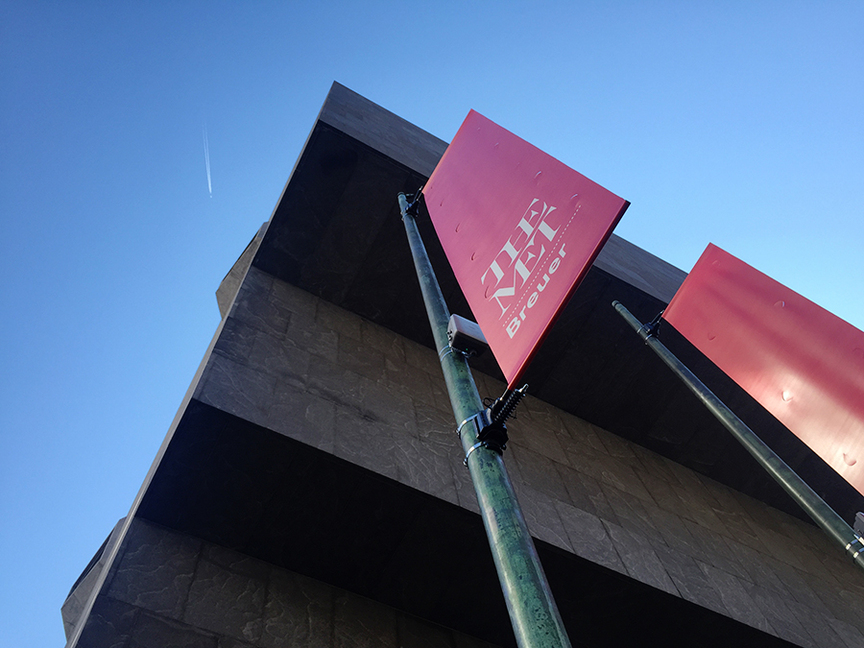
R
E
V N
E
X
T
After a round of museum musical chairs, New York City’s Metropolitan Museum of Art opened the doors to its new space—at least until 2023—in the Whitney Museum of American Art’s former uptown building. Newly christened the Met Breuer—so named for the building’s architect Marcel Breuer, whose design resulted in a dark, concrete, Brutalist inverted cube—two years of renovations did not yield a freshly rethought space as people might have expected.
The floors were polished, the concrete cleaned and chewing gum was “scraped from the holes in the walls,” joked Met CEO and director Thomas Campbell. “We removed the unnecessary wires that inevitably builds up in any building over a period of time,” he continued. Otherwise, not much of the renovations are evident to the naked eye—everything looks the same as they did in the former Whitney building, even down to the reliable Charles Simonds installation, Dwellings (1970–79,) located in the main stairwell, which was not allowed to be moved from the building.
An unignorable factor in this building merry-go-round is firstly money and funding. In order for the Whitney to stay afloat while maintaining two buildings—it moved into its new Renzo Piano space in the meatpacking district in May 2015—a lease was brokered some years ago with the Met to keep the former’s landmark Breuer building in operation. When Leonard A. Lauder (patriarch of the Estee Lauder cosmetics family and chairman emeritus of the Whitney) gifted USD 130 million to the Whitney in 2008, he had stipulated that it cannot sell the Breuer building. Thus, a partnership between the Whitney and the Met Museum was born.
Meanwhile, the Met Museum on Fifth Avenue announced in May 2014 that it would gut renovate its modern and contemporary Southwest Wing, originally completed in 1987. A year later it was revealed that renowned British architect David Chipperfield was chosen to develop the new design.
For now, New York City gets its first new museum endeavor since the 1977 opening of the New Museum. In recent years, new voices have certainly been injected into preestablished institutions to revitalize the latter’s brand—think Jeffrey Deitch for the Museum of Contemporary Art, Los Angeles or, more recently, Anne Pasternak for the Brooklyn Museum. The Met’s deep reach and reputation enabled them to obtain funding for much of its eight-year lease on the Breuer building; a much-discussed new logo and brand identity was also released to coincide with the Met Breuer opening.
Think of the Met Breuer as a curatorial studio for the institution to work out its new voice. It’s hiring of former Tate Modern curators is telling of the Met’s aims in defining this voice. As well, it will be interesting to see how the Met tackles the dilemma of the landmark Breuer building—the general public always seemed divided about loving or hating it as a venue for showing art—and, similarly, head curator Sheena Wagstaff’s work at the Met Breuer will most definitely be closely watched and critiqued. Tasking her team to “embrace and also look well beyond the Western cannon across many geographies,” Wagstaff would ultimately like to “both disrupt and expand histories as told through the art of our time.”
While this missive is thrilling, the team’s first offering “Unfinished: Thoughts Left Visible” didn’t quite deliver on a level of bearing witness to something new that is fresh and truly exciting. New York magazine art critic Jerry Saltz couldn’t have put it more succinctly, describing walking through the exhibit like a “Where’s Waldo?” game, trying to identify what the unfinished bits in the artworks presented instead of focusing more on the “thoughts left visible.”
The second of the Met Breuer’s inaugural exhibits is a retrospective solo show dedicated to the late Indian artist Nasreen Mohamedi (1937–1990) and includes a staggering 130 works spread out on an entire floor. The abstraction of her delicate and architectural line-based drawings and black-and-white photographs place her squarely in Minimalism and Modernism—as she was engaged with the ideas of both movements on a global level, and had ignored the more narrative and figurative styles that prevailed in India during her life and career.
And finally, one of the more unique aspects of the opening preview was hearing the jazzy music of acclaimed composer Vijay Iyer’s month-long residency play throughout the lobby. Iyer’s dedicated space located in a gallery on the ground floor has been turned into a musical cave, where his hand-picked collaborations, improvisations and provocations will be performed from opening to closing hours.
ArtAsiaPacific attended the Met Breuer’s opening earlier this month. Below are some highlights from the new museum space.



